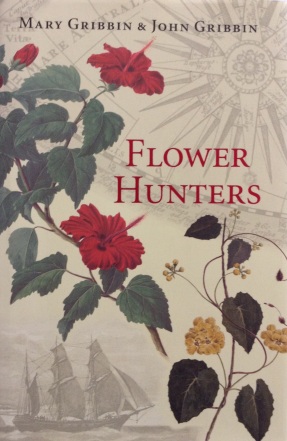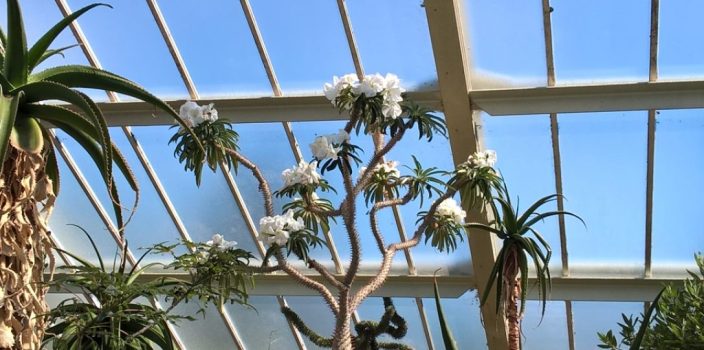
I’ve spent a fair amount of the last six months in the quiet corridors of the Manchester Museum Herbarium, helping with a lengthy transfer of packets of the General Moss collection from filing cabinet to boxes. Sifting through sheets and packets, I can trace the patterns that the personalities of the different collectors etch in the collection. I see the differences in packeting; ‘stuffers’ who see the size of the envelope as the minimum target and the ‘folders’, who encase tiny scraps in tissue-thin paper, the localities visited and the specimens selected which different personalities pick. It is inevitable that any Herbarium collection is filtered through the collectors’ passions and whims. Therefore, when I found a copy of Mary and John Gribbin’s Flower Hunters in the library, I picked it up out of a desire to learn more about the collectors whose specimens fill the shelves of herbaria throughout the world.
The book traces a history of botany up until the 20th century, when there still existed territories unaltered by human hands. There is a distinct horticultural slant, but does cover scientific and economic botany which interests me more. There is also more of a stress on Hunters than Flowers; biographic minutiae trumps botanical detail. I would have liked to have seen more on the bryophytological loves of Richard Spruce, for example, to get a feel for his mind and passions.
Across the biographical chapters of individual botanists, what piqued my interest was how class influence how these collectors could practice and were rewarded for their work. Whilst all suffered on arduous, years long journeys around the world, the gentleman (and gentlewoman) naturalist had a retinue and global connections. Their resources permitted the intellectual freedom to see global patterns in vegetation, which fueled evolutionary and ecological thinking. In contrast, working-class commercial plantsmen were sent out on their own and expected to keep their heads down, looking for the economically not intellectually fruitful, but only seeing the smallest slice of the profits their seeds and plants made.
The book is structured roughly chronologically, with each chapter on the life of a plant collector (or collaborating pair), hence showing the changing shape of science and adventure. The structure works well in the beginning, the early classification system of John Ray (1627-1705) is followed by the more familiar classification of Linnaeus (1707 – 1778). I was surprised to learn that Ray’s somewhat cumbersome classification based on essential features of the plant (such as the dicotyledon/ monocotyledon division still current) blended with Linnaeus’ user-friendly classification system based on somewhat arbitrary features (Crytogamia, anybody?) to create the bones of modern plant taxonomy. Linnaeus is not the origin of plant taxonomy, he had his own forerunners as well. We then move to Joseph Banks (1743 – 1820), the de facto first director of the Royal Botanic Gardens at Kew and friend of George III who accompanied Captain Cook on the Endeavour. Here scientific curiousity is inseparable from imperial ambition, Banks saw the land and flora of the Pacific as ripe for “improvement” and exploitation.
Then follows the plantsmen, sent as the somewhat disposable employees of private companies into unmapped territory. These include David Douglas (1799-1834) sent alone on starvation pay by the Royal Horticultural Society to discover and collect plants including his eponymous fir and the Sugar Pine in North America. Expected to live on the land and employ local guides, his health was ruined, losing most of his vision and becoming rheumatic. He died in a bizarre, tragic manner; on Hawaii, his poor eyesight caused him to fall into an animal trap where he was gored by the trapped bull.
We then move onto a pair of similarly intrepid plantsmen, William and Thomas Lobb, who also brought large trees back to their employers. But with the later plant hunter, Robert Fortune (1812-1880), the voyages become more routine. His work involved trading, officially and unofficially, with other plant breeders in China. His notable achievement was in service of the British Empire, he was the first to take viable tea seeds out of China to establish successful plantations in India, ending China’s monopoly on tea. Though economic considerations went into even Linnaeus’ botanising, consideration of profit becomes more naked and unscrupulous.
Bucking the arch of the narrative is the figure of Marianne North (1830-1890). A wealthy woman, she circled the globe without the expected chaperone, not plant hunting for profit or for a scientific institute (as none would employ a woman to do so) but for her art. She was an incredible prolific botanical artist who, unusually for the time, painted plants in situ. She worked rapidly and in oils, producing what the Gribbins describe as not highly detailed but more importantly accurate. They are not plants “murder[ed] to dissect” but alive in their habitat, an ecological not an anatomical painter. I am hesitant to criticize the inclusion of North as I admire her as an intrepid artistic woman. But she does stick out of a narrative trend of increasing commercialization of plants precisely because she was not a plant hunter, with all it’s masculine connotations. She did not bring back the plants themselves as trophies, but her own impressions of the plants and their environments captured in the paintings. If her story was in the context of a discussion of the growing ecological understanding, amongst the stories of Alexander von Humboldt and Alfred Russell Wallace for example, it would make sense. But here it feels like she was shoehorned as “the woman” in a history of a period and profession which was more or less uniformly masculine. The best way to appreciate women’s contribution to science is to place them in their intellectual context, not to include them in a place where their lives seem superfluous and dismissable.
The final story is that of Joseph Dalton Hooker (1817-1911), who I know best for the Bentham & Hooker System of classifying seed plants which the Manchester Museum Herbarium (and many other herbaria) arrange their specimens by to this day. This is not discussed in the book, sadly, as it would make a nice narrative circle from Ray and Linnaeus to Hooker. The focus is instead upon Hooker’s botanising in the Himalayas. He was one of the earliest Europeans to explore the Tibetan Plateau, and is largely responsible for the flourishing of rhododendrons in the gardens (and countryside!) of Britain. Less destructively, his collections form integral parts of many herbaria in Britain, including Manchester’s.
A book such as this does run the threat of superficiality and glaring omission (Darwin is conspicuously but understandably absent, but aside from Linnaeus there is an absent of the non-Britons). But more important is cohesion, which it ultimately lacks. It doesn’t make any conclusions about the state of botanical science in this period, merely presenting fascinating stories. A book which treated the hunters and their plants on the same level, giving biographical and evolutionary detail alongside each other, would have made maybe a more enjoyable, tightly structured book.
